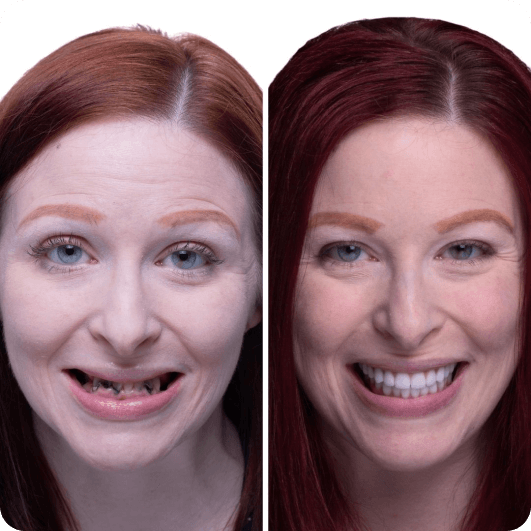Frequently asked questions
Feel free to contact us for any further inquiries
The number of visits required to complete a dental implant can vary depending on individual cases. In some rare instances, the entire implant procedure can be completed in a single day. However, in most cases, it typically takes three appointments.
During the first appointment, the implant is placed in the jawbone. Following this, a healing period of approximately 3-4 months is necessary to allow the implant to integrate with the bone.
The second appointment involves taking impressions of the implant to fabricate the implant crown.
Finally, 2-4 days after the second appointment, the crown is placed into the implant, completing the implant procedure.
It is important to note that these are general guidelines, and the exact number of visits required may vary depending on the specific case and the recommendations of your dental professional.
Traveling to Los Algodones, Mexico is generally considered safe. The region of Baja California, where Los Algodones is located, has a low crime rate, especially when it comes to violent crimes. In fact, the Dr. Parra Implant center, which has been operating for 40 years in the area, has seen very few instances of violent crime. However, it is always important to exercise caution and take necessary precautions while traveling to any destination.
We accept Visa, Mastercard, and cash as payment methods. Customers can choose to pay with their Visa or Mastercard, or they can opt to pay with cash. Additionally, we offer a 10% discount for customers who choose to pay in cash.
We use implants and components from reputable companies such as Straumann and Nobel Biocare. Both of these companies are well-known in the dental industry for their high-quality dental implant systems and components. These companies have a long-standing reputation for producing reliable and durable products that are widely used by dental professionals around the world. By working with these trusted suppliers, we can ensure that our patients receive the best possible dental implant solutions.
While we do not directly accept insurance, we are more than happy to assist you in filling out reimbursement forms. We understand that dealing with insurance can be a complex process, and we want to make it as easy as possible for you. Our team is knowledgeable and experienced in handling reimbursement forms, and we will provide guidance and support to ensure that you receive your reimbursement.
Crowns and veneers are both dental restorations used to improve the appearance and function of teeth, but they serve different purposes and involve different levels of tooth preparation.
A dental crown, also known as a dental cap, is a restoration that covers the entire visible portion of a tooth. It is typically used to restore a tooth that is severely damaged, decayed, or weakened. The tooth is prepared by removing a significant amount of its structure to make room for the crown. Crowns are often recommended for teeth that have undergone root canal treatment or have large fillings. They provide strength, support, and protection to the underlying tooth structure.
On the other hand, dental veneers are thin, custom-made shells that are bonded to the front surface of the teeth to improve their appearance. Veneers are commonly used to enhance the aesthetics of teeth that are discolored, chipped, misaligned, or have gaps between them. Unlike crowns, veneers require minimal tooth preparation, usually involving the removal of a thin layer of enamel. Veneers are a more conservative option compared to crowns as they preserve more natural tooth structure.
Your Treatment Path
For patients undergoing the All-on-4/6 dental implant procedure, the treatment typically involves multiple trips to the dentist's office to complete the process. Here is a breakdown of the different appointments and their durations:
The first trip, which lasts approximately 3-4 days, involves several important steps. On the first day, the patient has a consultation with the dentist to discuss their specific needs and expectations. The following day, the surgery takes place, where the dental implants are placed. On the third day, a post-surgery check-up is conducted to ensure proper healing and address any concerns. If necessary, an additional check-up may be scheduled on the fourth day.
Approximately four months later, the patient returns for the second trip, which lasts about a week. The purpose of this visit is to proceed with the prototype phase. On the first day, an X-ray is taken, and the dentist assesses the healing progress. If required, the dentist orders the necessary components for the next steps. The second day is dedicated to taking impressions for the prototype, which typically takes the entire day. On the third day, fittings are done to ensure a proper fit. By the fourth day, the first prototype is ready to be placed, and pictures and molds are taken for reference. Finally, on the fifth day, a check-up is conducted to make any necessary adjustments.
The third and final trip involves the placement of the final zirconia hybrid prosthesis. This trip takes place one to three months after the second trip. This trip typically lasts at least two days. On the first day, the zirconia hybrid is securely placed, providing the patient with a permanent solution. On the second day, any adjustments that may be required are made to ensure optimal comfort and functionality.
Throughout the entire process, the dentist closely monitors the patient's progress and ensures that all steps are carried out with precision and care. By following this structured treatment plan, patients can achieve a fully restored smile and regain their confidence in their dental health.
Book your appointment
